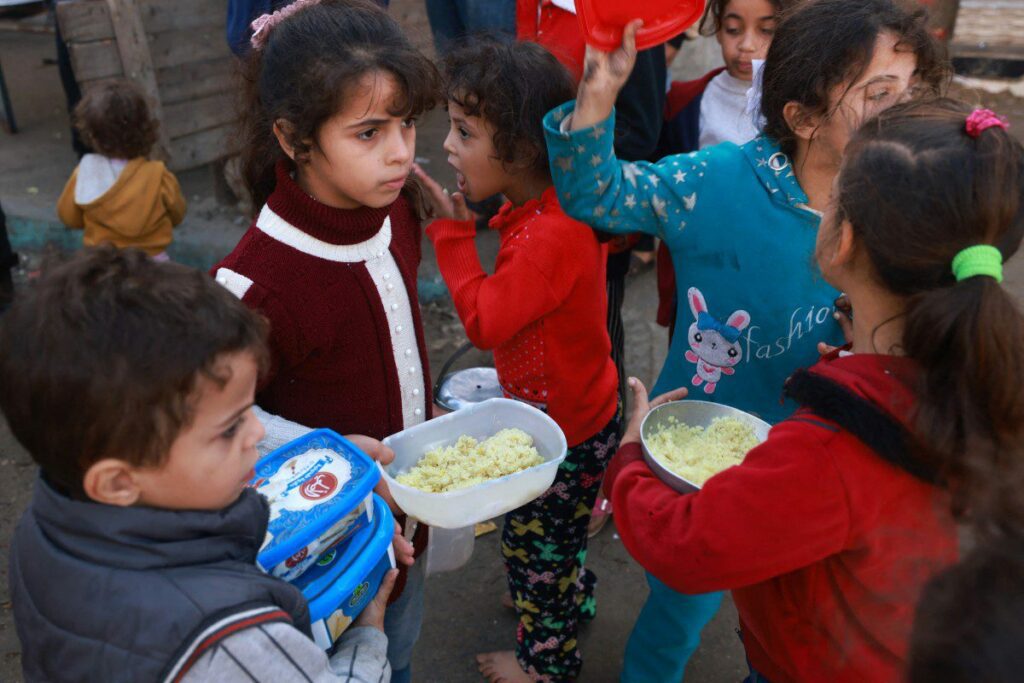More than 6,000 children were brutally killed by bombs, rockets, and bullets during the Israeli war on Gaza. The money put into purchasing these weapons could have fed millions of starving children around the world.
More than 6,000 children were killed with indescribable brutality and under the watchful eyes of regimes, states, and organizations that are complicit, have turned a blind eye, or at best, verbally condemned the actions.
Thus, in front of the lens of the camera, sometimes as voyeurs, sometimes witnesses, and often as protectors, we all bear witness to children paralyzed, trembling, shocked, terrified, and heartbroken. We watch as they search for a mother, a father, a brother, or someone to reassure them that the pain will ease and the wound will heal.

According to UNRWA estimates, children make up half of the population of the Gaza Strip, which amounts to 2.3 million people. They live in harsh conditions and suffer from an acute shortage of food and a lack of clean water. They move from one place to another trying to find a safe place to live, but they find themselves exposed and vulnerable.
More than half of Gaza’s population lives in a precarious state of displacement, and displaced people, the majority of them women and children, are forced to seek shelter in UN-run shelters. There, some 700 people share a single shower and 150 people share a single toilet. These conditions open the door to the spread of various diseases and epidemics. In addition, children face great challenges in such an environment, including abuse, violence, and sexual harassment.
6,000 were killed, and thousands of children may still be under the rubble. And those who survived lost a leg, a hand, or sight, a brother, a sister, or a mother…or maybe they were the sole survivor from their families. One eleven-year-old girl said her family died and she and two of her brothers survived. “I am a child, how can I take care of two children?” she screams, crying and wiping away her tears as she is left alone.
The systematic killing of children in Gaza may set a global precedent in terms of deaths, as Save the Children International reported that the number of children killed by Israeli bombings in Gaza exceeded the annual number of children killed in all global conflict zones since 2019. Those who survived are left to live in harsh conditions that cannot even be imagined. How can we heal the pain that gnaws at the hearts of the frightened and confused looking children?
As the bombing and violence continues, the impact of the war on children can be clearly seen through the worsening of symptoms of shock and anxiety, which cause serious psychological effects. This is especially true as many boys and girls arrive at emergency rooms without a family member to accompany them. For the past month, doctors have been monitoring symptoms of severe shock. These include convulsions, bed-wetting, constant anxiety, fear, aggressive behavior and nervousness.
Within this context, we must shed light on the countless children who have become orphans or perhaps lost all extended family members. UNRWA has indicated that unaccompanied children during wars are more vulnerable to the risk of violence, mistreatment, neglect, exploitation, and military recruitment. Additionally, many unaccompanied and separated children are unable to access essentials such as food, clean water, and shelter.
Although these are some of the tangible and direct effects of the brutality experienced by children in Gaza, the psychological effects of war may have a broader dimension. Studies indicate that children who grow up in the midst of war are at greater risk of developing difficult behavioral problems related to the trauma they have been exposed to.
A 2018 study in the World Psychiatry Journal titled “The Mental Health of Children Living in War Zones: A Risk and Protection Perspective,” shows that about one-third of children who have been exposed to war trauma suffer from post-traumatic stress disorder (PTSD) and depression, which are among the most common disorders in both adults and children. For children especially, the effects of war trauma have a wide range of implications, such as the ability to form family relationships and positive peer interactions.


Although these international studies often point to facts, they tend to ignore the connection of these results to specific frameworks, contexts, and local specificities. This leads to errors of generalization and the transformation of children into mere statistics, numbers, and proportions. These studies forget to point out the lack of adequate interventions and services needed to protect children in the present. Instead of stigmatizing the killer, international organizations are spending millions of dollars to chart the fate of children and are now preparing to raise funds for post-trauma intervention.
Psychiatrist Dr. Dina Jibreel Allouche confirmed that we are often tempted to describe the future of the children of Gaza: “Instead of stigmatizing destinies and judging the future, we must focus on what must be done now so that the killing machine stops its crimes and so that children have the feeling that their lives have value.”
Dr. Allouche adds that every boy and girl is a special being, has an individual path, a history, and memories that can turn survival into an act of victory, create a space to break the silence, and draw a future that defeats what the murderer is seeking.
Lying on the bed in the emergency room, a seven-year-old girl asks the doctor as she tosses and turns in the pain of being alone and badly burned.
“Uncle, uncle, I want to ask you: Uncle, is this a dream or is it real?”
This child’s question will be a disturbance to the murderer, because it is a question that rejects the act of killing and condemns it in the most noble way.






